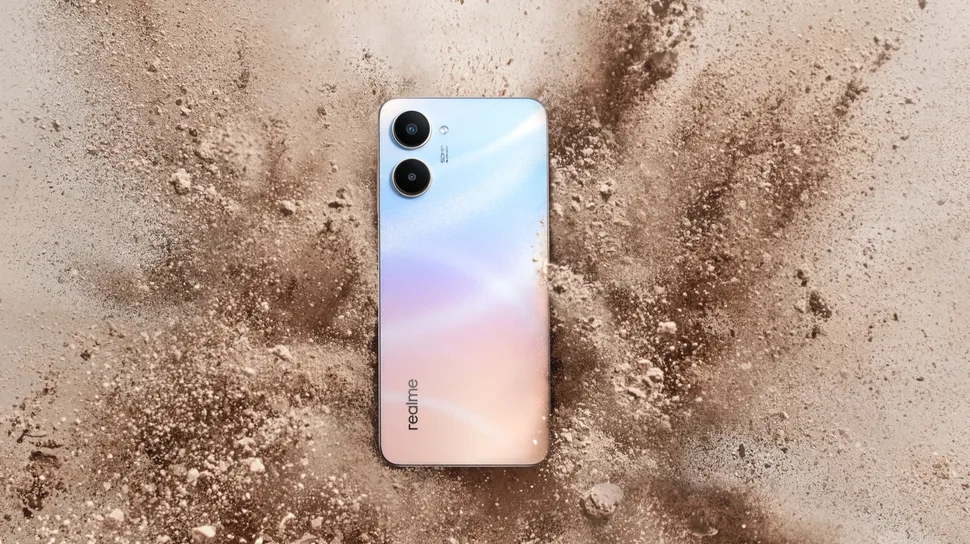The Realme 10 is one of the greatest low-cost phones available, so you might have found it. On paper, this new phone has some promising specs and seems like a major improvement over the Realme 9, but we won’t know for sure until we’ve done a thorough study.
Highlights include a large battery, enhanced power, a thin design, and a 90Hz AMOLED screen. However, this phone is much more than that.
All of the important information about the Phone is provided below, along with information about the Realme 10 Pro and Realme 10 Pro Plus, which are now only available in Asia but will soon be released globally.
Design and Display
According to the business, “particles that travel at light speed” served as the inspiration for the Realme 10’s design. In actuality, that implies that it comes in the colors “Clash White” and “Rush Black,” but these aren’t just black and white hues; rather, they both have a smattering of colors with tiny white dots.
The business claims that this is the slimmest Realme phone ever released for the worldwide market, with dimensions of 159.9 x 73.3 x 7.95 mm and a weight of 178g. As seen in the images in this post, it has two sizable camera housings on the back and a punch-hole camera on the front.
The manufacturer hasn’t said if the device is made of plastic or not. Water resistance isn’t mentioned either, but at this price, that’s not shocking.
The 6.4-inch 1080 x 2400 Super AMOLED screen has Gorilla Glass 5 protection, a refresh rate of 90 Hz, and a maximum brightness of 1000 nits. Although the Realme 9’s screen has the same specifications, we were impressed by it during our review.
In contrast, the Realme 10 Pro and Realme 10 Pro Plus share a similar appearance, although the brand claims that the “hyperspace design” is influenced by refracted light. One of the pictures below gives you a sense of how this appears.
The Pro and Pro Plus are available in Hyperspace, Dark Matter, and Nebula Blue hues; it appears that only the Hyperspace option provides the previously mentioned appearance.
Both of them have a 6.7-inch screen with Full HD+ resolution and a refresh rate of 120 Hz, however the Realme 10 Pro Plus’s screen is curved, and the Realme 10 Pro’s is flat with thin 1mm bezels.
Camera and Battery
Although the 50MP f/1.8 primary camera has respectable stats, it is joined by a 2MP f/2.4 black and white (i.e., monochrome) sensor. This makes the dual-lens camera on the back of the phone seem less spectacular.
Furthermore, the Realme 10 may be a downgrade in this case because the Realme 9 really boasts a triple-lens camera, which includes a 108MP main sensor.
However, Realme asserts that the shutter speed is 121% faster than on the previous model and that the new phone has an improved night mode that lowers noise. Additionally, there is a 16MP f/2.45 front-facing camera.
The Realme 10 Pro Plus contains a 108MP primary camera, an 8MP f/2.2 ultra-wide camera, and a 2MP f/2.4 macro lens. In contrast, the Realme 10 Pro has a 108MP f/1.75 primary camera and a 2MP f/2.4 portrait lens. Additionally, both phones feature a 16MP selfie camera.
All three of Realme’s phones have 5,000mAh batteries, which is a respectable but rather ordinary size. In the case of the Realme 10 and 10 Pro, this supports 33W charging, which, according to Realme, can charge the phone from 50% to 100% in 28 minutes. Meanwhile, 67W charging is supported by the Realme 10 Pro Plus.
Specs and Features
The Realme 10 has a MediaTek Helio G99 CPU, which is a contemporary but reasonably low-end chipset, and 8GB of RAM. To increase it to 16GB, the phone also allows you to use storage as virtual RAM.
According to the manufacturer, this phone’s gaming performance is good considering its budget, citing the ability to play PUBG Mobile on Balanced mode at 40 frames per second.
A microSD card slot and 64GB, 128GB, or 256GB of storage are available; however, not all locations may have these versions, and since this is only a 4G phone, 5G is a significant feature that is lacking.
Features of the Realme 10 include a 3.5mm headphone connection, the company’s Realme UI 3.0, which is based on Android 12, and a “UltraBoom” speaker that claims to play Hi-Res music at 200% volume.
With a Snapdragon 695 chipset, 6GB or 8GB of RAM, and 128GB of storage, the Realme 10 Pro ought to be a little more potent. 5G is also supported.
With a MediaTek Dimensity 1080 CPU, up to 12GB of RAM (with 12GB of dynamic RAM), 5G, and up to 256GB of storage, the Realme 10 Pro with is even better.
Because the Pro and Pro Plus run Realme UI 4.0, which is based on Android 13, they also feature more recent software.
